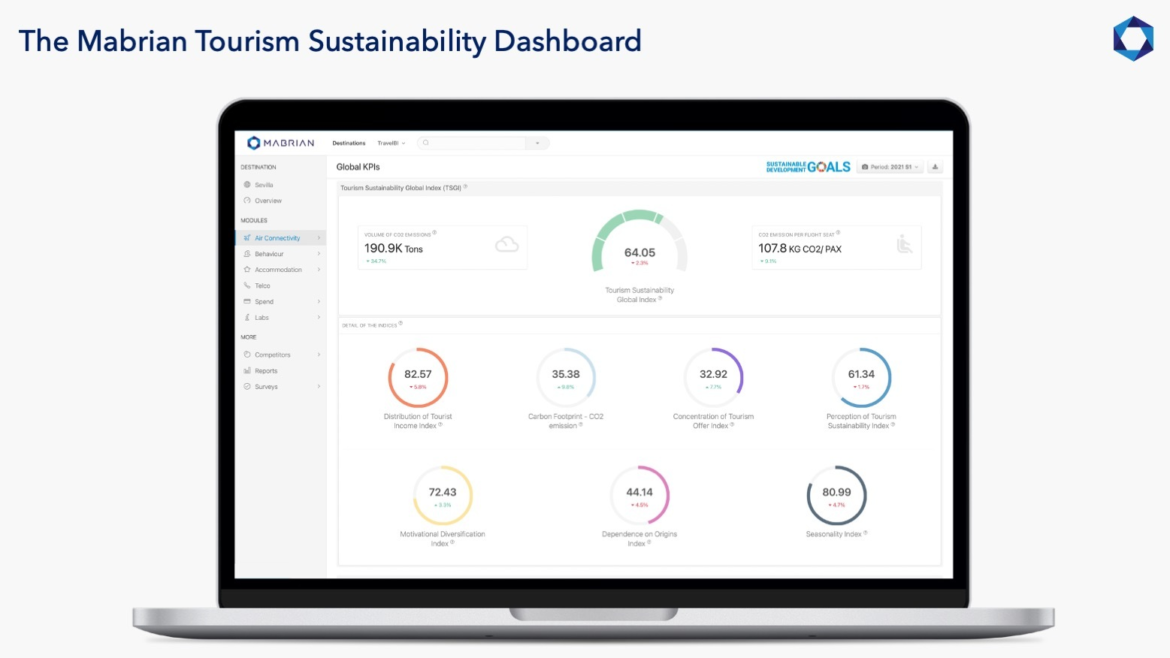Palma, April 7, 2022. Mabrian Technologies, a leading tourism data and intelligence company, has calculated, compared and analyzed the carbon footprint of visitors arriving by air for the main Mediterranean destinations for the years of 2019 and 2022. To do this, the emissions of CO2 due to incoming air connectivity have been calculated in countries such as Portugal, Spain, France, Italy and Greece. The data for each country includes flights from any origin anywhere in the world to any airport within that country, and both the average carbon footprint per passenger as well as the total emissions emitted are calculated.
- Mabrian, in a new study based on tourism data and intelligence, compares the aviation carbon footprint of the main Mediterranean destinations for 2019 with 2022
- CO2 emissions have been calculated – in total and per passenger – for incoming air connectivity into all airports in Portugal, Spain, France, Italy and Greece, including all origins
- The company presents its new carbon footprint indicator, which is added to its platform of tourism sustainability indices for destinations
This study is published at the Sustainable Destinations Summit organized this week by the World Tourism Organization (UNWTO) in Mallorca, where Mabrian will participate as a speaker. During the event Mabrian will launch this new indicator of tourist sustainability that will be used from now on to calculate the global tourism sustainability impact of destinations. This new indicator joins the other tourism sustainability indices that Mabrian has been calculating and analyzing for destinations since launching last year.
For this study published today, the new indicator has analyzed the carbon footprint that will be generated by the arrival of visitors by air to the five most important holiday tourist destinations in Europe (Portugal, Spain, France, Italy and Greece) between January and October 2022 – and is compared with the same period in 2019. For this calculation, the volume of scheduled incoming seats in this period for all destination airports in these countries is used as a criterion, calculating emissions with an estimate of occupied seats and the carbon footprint generated by the flights depending on the routes and the type of aircraft.
The conclusions reached after the analysis of these tourist data are:
- In total, the destinations studied will emit between January and October this year 46.5 million tonnes of CO2 into the atmosphere due to air connectivity. This represents a reduction of 19% compared to the same period in 2019.
- However, the reduction in incoming air seats for these destinations between January and October is only 7.23% compared to 2019 – which shows an improvement in CO2 efficiency.
- Meanwhile, the average carbon footprint per passenger is reduced by 5% compared to 2019, going from an average of 120 kg/passenger to 114 kg/passenger.
- The reduction in intercontinental travel and the renewal of fleets with more fuel-efficient models by airlines are favouring this positive evolution.
By country, the results are as follows:
- Spain is the destination that emits the most carbon footprint as it is the country that will receive the most visitors. However, its average carbon footprint per visitor is lower than that of France or Portugal.
- Greece is the country that shows the best efficiency in average CO2 per passenger received during 2022 with 97.72 kg/passenger, 14% below the average of the rest of the destinations. This is despite being the only destination that will increase its total emissions during 2022, since it also expects to receive more visitors: the total tonnes of CO2 emitted will increase by 4.6%.
- Italy and Portugal are the destinations that most manage to reduce their carbon footprint per passenger, reducing 1.8% and 9% respectively.
- France is the only one of the five countries analyzed that will increase emissions per passenger during 2022 compared to 2019, by 2.9%. However, it has the second-highest reduction in total emissions, by 24%. This is only behind Italy, which reduces emissions by 28% compared to 2019.
Carlos Cendra, Marketing & Sales Director at Mabrian Technologies, states that: “this indicator is a great tool to measure the environmental impact of the arrival of visitors to a destination by air and it will allow destination managers to act in collaboration with the airlines. The dependence on remote markets, the occupation levels of flights and the type of aircraft offered by the companies are all relevant aspects to take into account in order to reduce the impact of the carbon footprint of a destination.”
“As we will propose at the Sustainable Destinations Summit organized by the UNWTO and the Consell Insular de Mallorca, destinations must take the initiative and lead the change in model, but for this they need measurement tools such as those that we can offer them through our tourist intelligence and big data analysis.”
To speak with Mabrian contact Roman Townsend on rtownsend@belverapartners.com








